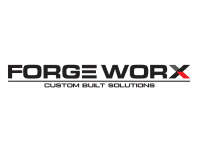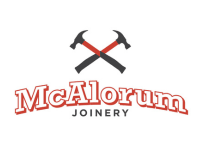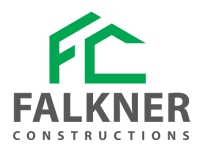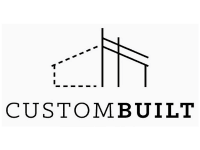The Australian construction industry is evolving rapidly, with significant government initiatives, private sector investments, and emerging construction trends in Australia reshaping the sector. From large-scale school upgrades to defense-related infrastructure projects, these developments are reshaping the landscape for builders and planners alike.
Navigating these shifts requires more than just technical expertise—it calls for proactive planning and a deep understanding of the market. Builders and cost planners who stay ahead of these recent trends in Australian construction can capitalize on emerging opportunities while mitigating risks.
This blog explores key developments shaping the industry, their implications for builders, and strategies to maintain a competitive edge in 2025. Whether you’re managing urban projects or tackling rural challenges, understanding these trends is essential to thrive in the evolving construction market.
Government Projects Leading Construction Trends in Australia
Australia’s construction industry has seen a surge in government-funded initiatives, signaling significant opportunities for builders and planners. From large-scale educational upgrades to defense-related infrastructure, these projects are reshaping the sector while emphasizing the need for strategic cost planning.
1. Major Investments in Education
Government initiatives are a major driver of construction trends in Australia, with billions committed to modernizing and expanding school infrastructure. In South Australia alone, nearly $200 million has been allocated for educational facilities, including upgrades to primary and secondary schools.
- Impact on Builders: These projects often involve strict timelines and compliance requirements, making accurate cost planning essential to deliver value within budget.
- Example: A $25 million redevelopment at a regional school demonstrates how these investments are transforming education while creating opportunities for contractors and suppliers.
2. Defense Infrastructure and the AUKUS Pact
The AUKUS agreement is driving an unprecedented expansion of defense infrastructure. Projects include upgrading naval bases and developing facilities to accommodate cutting-edge technologies.
- Implications for Construction: Builders involved in these projects must navigate specialized requirements, such as security standards and precision engineering.
- Example Insight: Perth-based firms have reported growth due to their role in naval base upgrades, highlighting the expanding opportunities in defense-related construction.
3. Regional Development and Its Role in Construction Trends in Australia
Many government projects are strategically located in regional areas, aiming to stimulate local economies. These developments often require extensive collaboration with local suppliers and subcontractors.
- Opportunity for Planners: Accurate cost planning ensures that logistical challenges, such as transporting materials to remote locations, are factored into project budgets.
- Example: A rural school project faced additional costs due to delayed material deliveries, but a detailed contingency fund ensured the project stayed on track.
How These Projects Shape the Industry
Government-funded initiatives not only drive economic growth but also raise the bar for compliance, sustainability, and innovation in construction. Builders who align with these values through proactive cost planning and efficient execution will secure their place in Australia’s evolving construction landscape.
Private Sector Investments Shaping Construction Trends in Australia
In addition to government-led initiatives, the private sector is playing a pivotal role in shaping Australia’s construction industry. Significant investments in retail, data centers, and other commercial projects are creating new opportunities for builders and cost planners.
1. Retail Precincts: Supporting Local Economies
New retail developments are emerging in fast-growing regions, reflecting key construction trends in Australia. For example, a retail precinct recently approved in South Nowra will provide a boost to the local economy and create employment opportunities.
- Opportunity for Builders: These projects often involve mixed-use spaces, requiring detailed cost planning to balance commercial and logistical needs.
- Example Insight: A contractor secured a retail project by presenting a comprehensive cost estimate that accounted for fluctuating material prices and transport challenges.
2. Data Centers as Key Drivers of Construction Trends in Australia
With the increasing reliance on cloud computing, the demand for data storage infrastructure is soaring. Recent plans for a $450 million mega data center in Sydney highlight this trend.
- Impact on the Industry: Data centers require specialized construction techniques, such as advanced ventilation systems and secure facilities, emphasizing the importance of precise estimating.
- Example Insight: Builders who specialize in high-tech facilities can leverage this trend by aligning their services with the specific needs of data center construction.
3. Commercial Growth in Suburban Areas
Suburban hubs are becoming focal points for commercial expansion. These developments aim to reduce congestion in major cities while creating opportunities for regional contractors.
- Opportunity for Cost Planners: Projects in suburban areas often face unique challenges, such as integrating green spaces and ensuring accessibility, which must be carefully incorporated into cost plans.
- Example: A retail complex in Melbourne’s outer suburbs implemented eco-friendly construction techniques, which were seamlessly budgeted into the project thanks to proactive planning.
Why Private Investments Matter
Private sector projects drive innovation, diversify opportunities for builders, and push the industry toward sustainable practices. Accurate cost planning ensures that builders can meet the complex demands of these projects while remaining competitive.
Challenges Impacting Construction Trends in Australia
While Australia’s construction industry is shaped by growth through government and private sector investments, several challenges continue to influence construction trends in Australia. From rising costs to regulatory hurdles, these obstacles emphasize the importance of strategic cost planning
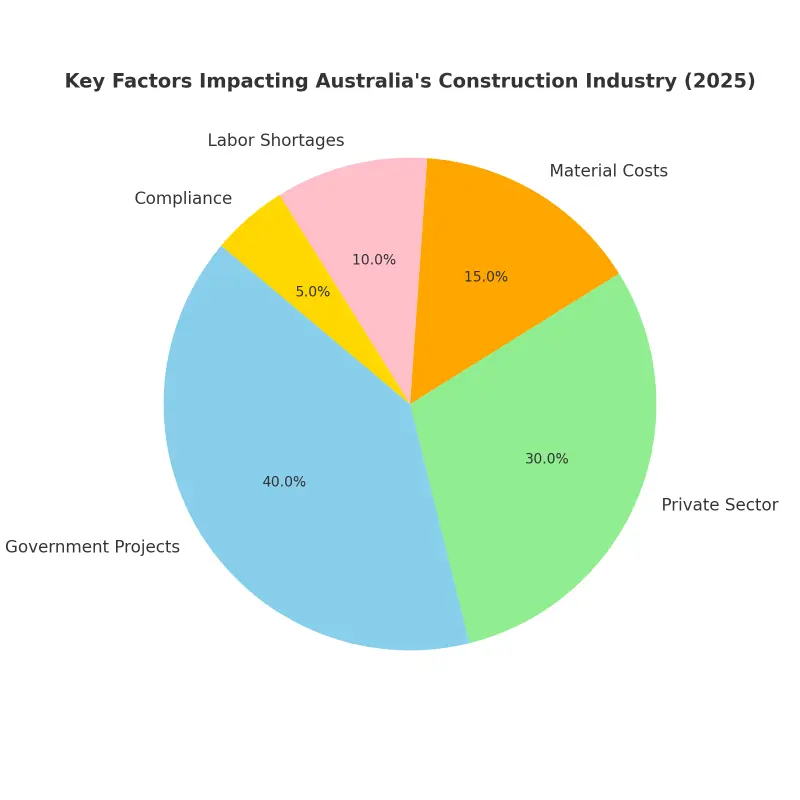
This pie chart illustrates the key factors impacting Australia’s construction industry in 2025, emphasizing the need for strategic planning and adaptability.
1. Rising Material Costs
Rising material costs are one of the key factors shaping construction trends in Australia. The global supply chain continues to impact material availability and pricing. For example, timber and steel costs have seen periodic spikes, adding pressure to already tight project budgets.
- Impact on Projects: Unexpected material price increases can lead to budget overruns and project delays.
- Solution: Builders must adopt real-time pricing tools like Cordell Cost Guides and secure supplier contracts early to mitigate these risks.
- Example Insight: A Sydney-based builder avoided a 15% cost increase on a high-rise project by locking in material prices before a global price hike.
2. Decline in Housing Approvals
Recent data from the Australian Bureau of Statistics shows a 3.6% decline in housing approvals, raising concerns about the country’s ability to meet housing demand.
- Implications for Builders: Reduced housing approvals can result in fewer residential projects, putting pressure on builders to diversify their portfolios.
- Solution: Accurate cost planning ensures that builders can optimize budgets for the projects they secure, making them more competitive in a challenging market.
3. Labor Shortages
The construction industry faces a persistent shortage of skilled labor, particularly in rural areas.
- Impact on Projects: Labor shortages can delay timelines and increase costs due to higher wages and overtime.
- Solution: Collaborating with local trade schools and offering upskilling programs can help address labor gaps.
- Example Insight: A rural contractor partnered with a vocational school to train apprentices, ensuring a steady supply of skilled workers for ongoing projects.
4. Compliance Requirements Shaping Construction Trends in Australia
Compliance with Australian standards, such as BASIX and the NCC, adds complexity to project planning. Builders must allocate resources to meet these requirements without compromising timelines or budgets.
- Solution: Including compliance costs in the initial cost plan ensures that builders can avoid delays caused by regulatory revisions.
- Example: A Melbourne developer budgeted $20,000 for energy efficiency upgrades to meet BASIX standards, preventing approval delays.
Why Overcoming These Challenges Matters
Successfully addressing these challenges requires foresight, adaptability, and precise cost planning. Builders who tackle rising costs, labor shortages, and regulatory demands head-on can position themselves as industry leaders while ensuring project success.
How Accurate Cost Planning Addresses These Trends
Amid the challenges and opportunities in Australia’s construction industry, accurate cost planning emerges as a critical tool for builders and planners. By leveraging proactive strategies and advanced tools, businesses can navigate uncertainties, optimize resources, and deliver successful projects.
1. Managing Material Costs with Precision
Rising material prices can derail projects without proper planning. Accurate cost planning allows builders to anticipate market trends and secure materials at the best prices.
- Key Strategy: Use real-time pricing tools like Cordell Cost Guides to track fluctuations and negotiate bulk purchases.
- Example: A Perth-based contractor saved 10% on a large infrastructure project by securing steel contracts months ahead of a global price surge.
2. Mitigating Labor Shortages
Labor availability often varies between urban and rural projects, impacting timelines and costs. Accurate cost planning incorporates labor projections to address these disparities effectively.
- Key Strategy: Partner with local trade schools and invest in upskilling programs to build a sustainable workforce.
- Example: A rural project in Queensland reduced delays by allocating resources to train apprentices, ensuring skilled labor availability throughout the build.
3. Ensuring Compliance and Efficiency
Meeting Australian standards like BASIX and the NCC often involves additional costs and timelines. Incorporating these into cost plans ensures projects stay on track.
- Key Strategy: Work with quantity surveyors to include compliance-related expenses in the initial budget.
- Example: A Melbourne developer avoided approval delays by budgeting for energy-efficient upgrades during the planning phase.
4. Enhancing Client Confidence Amid Construction Trends in Australia
Transparent and detailed cost plans foster trust with clients, reducing conflicts and ensuring smoother project execution.
- Key Strategy: Present cost breakdowns with clear contingencies to align client expectations with project realities.
- Example: A Sydney contractor retained a high-value client by demonstrating how their cost plan minimized risks while maximizing value.
5. Future-Proofing with Technology
Advanced tools streamline cost planning, allowing builders to adapt quickly to changes in market conditions.
- Key Strategy: Use platforms like CostX to perform detailed quantity takeoffs and dynamic budget adjustments.
- Example: A commercial builder in Brisbane reduced project delays by 15% using CostX to automate updates in their cost plan as material prices shifted.
How Accurate Cost Planning Secures Success
Accurate cost planning isn’t just about numbers—it’s about foresight, strategy, and delivering value. Builders who adopt these practices are better equipped to navigate challenges, seize opportunities, and thrive in Australia’s competitive construction industry.
The Bottom Line on Cost Planning
The Australian construction industry, shaped by evolving construction trends in Australia, presents both opportunities and challenges that demand foresight and strategic planning. Accurate cost planning has proven to be the foundation for success, empowering builders to tackle rising material costs, labor shortages, and compliance complexities while delivering projects on time and within budget.
From government-funded initiatives to private sector innovations, staying ahead of industry trends is critical for builders and cost planners aiming to thrive in this competitive market. By adopting advanced tools, planning contingencies, and aligning with client expectations, you can position your business as a leader in the field.
Let Us Help You Succeed
Are you ready to transform your approach to construction estimating? Matrix Estimating offers expert cost planning services tailored to Australian builders. Whether you’re working on urban developments or regional projects, our team ensures accuracy, efficiency, and profitability.
Contact us today to learn how we can support your next project or explore our Comprehensive Guide to Construction Estimating for more insights.





